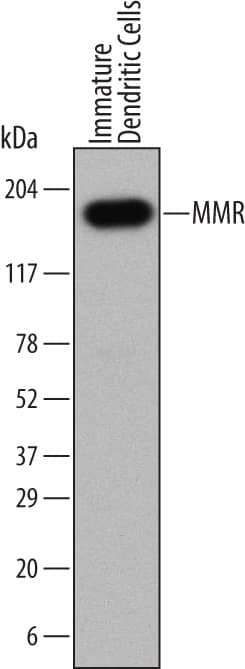Human MMR/CD206 Antibody
R&D Systems, part of Bio-Techne | Catalog # MAB25341

Key Product Details
Species Reactivity
Validated:
Human
Cited:
Human
Applications
Validated:
Immunohistochemistry, Simple Western, Western Blot
Cited:
Immunohistochemistry, Immunohistochemistry-Paraffin
Label
Unconjugated
Antibody Source
Monoclonal Mouse IgG2B Clone # 685645
Product Specifications
Immunogen
Mouse myeloma cell line NS0-derived recombinant human MMR/CD206
Leu19-Lys1383 (Thr399Ala) & (Leu407Phe),
Accession # P22897
Leu19-Lys1383 (Thr399Ala) & (Leu407Phe),
Accession # P22897
Specificity
Detects human MMR/CD206 in direct ELISAs and Western blots. In direct ELISAs, no cross-reactivity
with recombinant mouse (rm) MMR or recombinant human Mrc2 is observed. In
Western blots, approximately 25% cross-reactivity with rmMMR is observed.
Clonality
Monoclonal
Host
Mouse
Isotype
IgG2B
Scientific Data Images for Human MMR/CD206 Antibody
Detection of Human MMR/CD206 by Western Blot.
Western blot shows lysates of human immature dendritic cells. PVDF Membrane was probed with 1 µg/mL of Mouse Anti-Human MMR/CD206 Monoclonal Antibody (Catalog # MAB25341) followed by HRP-conjugated Anti-Mouse IgG Secondary Antibody (Catalog # HAF007). A specific band was detected for MMR/CD206 at approximately 150 kDa (as indicated). This experiment was conducted under reducing conditions and using Immunoblot Buffer Group 1.MMR/CD206 in Human Liver.
MMR/CD206 was detected in immersion fixed paraffin-embedded sections of human liver using Mouse Anti-Human MMR/CD206 Monoclonal Antibody (Catalog # MAB25341) at 15 µg/mL overnight at 4 °C. Before incubation with the primary antibody, tissue was subjected to heat-induced epitope retrieval using Antigen Retrieval Reagent-Basic (Catalog # CTS013). Tissue was stained using the Anti-Mouse HRP-DAB Cell & Tissue Staining Kit (brown; Catalog # CTS002) and counterstained with hematoxylin (blue). Specific staining was localized to endothelial cells in sinusoids. View our protocol for Chromogenic IHC Staining of Paraffin-embedded Tissue Sections.Detection of Human MMR/CD206 by Simple WesternTM.
Simple Western lane view shows lysates of human immature dendritic cells, loaded at 0.2 mg/mL. A specific band was detected for MMR/CD206 at approximately 228 kDa (as indicated) using 20 µg/mL of Mouse Anti-Human MMR/CD206 Monoclonal Antibody (Catalog # MAB25341). This experiment was conducted under reducing conditions and using the 66-440 kDa separation system.Applications for Human MMR/CD206 Antibody
Application
Recommended Usage
Immunohistochemistry
8-25 µg/mL
Sample: Immersion fixed paraffin-embedded sections of human liver
Sample: Immersion fixed paraffin-embedded sections of human liver
Simple Western
20 µg/mL
Sample: Human immature dendritic cells
Sample: Human immature dendritic cells
Western Blot
1 µg/mL
Sample: Human immature dendritic cells
Sample: Human immature dendritic cells
Reviewed Applications
Read 3 reviews rated 4.3 using MAB25341 in the following applications:
Formulation, Preparation, and Storage
Purification
Protein A or G purified from hybridoma culture supernatant
Reconstitution
Sterile PBS to a final concentration of 0.5 mg/mL. For liquid material, refer to CoA for concentration.
Formulation
Lyophilized from a 0.2 μm filtered solution in PBS with Trehalose. *Small pack size (SP) is supplied either lyophilized or as a 0.2 µm filtered solution in PBS.
Shipping
Lyophilized product is shipped at ambient temperature. Liquid small pack size (-SP) is shipped with polar packs. Upon receipt, store immediately at the temperature recommended below.
Stability & Storage
Use a manual defrost freezer and avoid repeated freeze-thaw cycles.
- 12 months from date of receipt, -20 to -70 °C as supplied.
- 1 month, 2 to 8 °C under sterile conditions after reconstitution.
- 6 months, -20 to -70 °C under sterile conditions after reconstitution.
Background: MMR/CD206
References
- East, L. and C. Isake (2002) Biochim. Biophys. Acta 1572:364.
- Chieppa, M. et al. (2003) J. Immunol. 171:4552.
- Figdor, C. et al. (2002) Nat. Rev. Immunol. 2:77.
- Taylor, M. et al. (1990) J. Biol. Chem. 265:12156.
- Leteux, C. et al. (2000) J. Exp. Med. 191:1117.
- Martinez-Pomares, L. et al. (2001) Immunobiology 204:527.
- Feinberg, H. et al. (2000) J. Biol. Chem. 275:21539.
Long Name
Macrophage Mannose Receptor
Alternate Names
CD206, CLEC13D, MRC1
Gene Symbol
MRC1
UniProt
Additional MMR/CD206 Products
Product Documents for Human MMR/CD206 Antibody
Product Specific Notices for Human MMR/CD206 Antibody
For research use only
